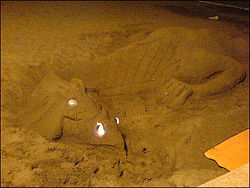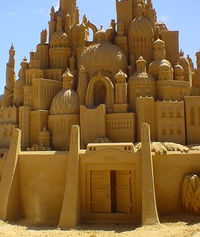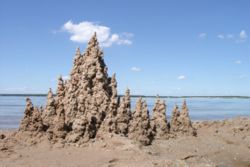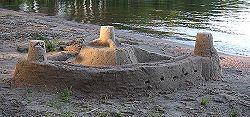Sand art and play
2008/9 Schools Wikipedia Selection. Related subjects: Recreation

A sand castle is a type of sand sculpture resembling a miniature building, often a castle. The two basic building ingredients, sand and water, are available in abundance on a sandy beach, so most sand play takes place there, or in a sandpit.
A variant on the sandcastle is the drip castle, made by mixing the sand with water and dripping it from a fist held above. Some refer to the technique as "dribbling." When the slurry of sand and water lands on existing sand structures, the effect is Gaudi-esque.
Sand castles are typically made by children, simply for the fun of it, but there are also sand sculpture contests for adults that involve large, complex constructions.
An example of extremely sophisticated sand art is the Buddhist mandala.
Competition
Since 1989, a World Championship in Sand Sculpture has been held in Harrison Hot Springs (Canada, BC), also known as " Harrisand." The competition has solo, double and team categories. The world's tallest sandcastle was built on Myrtle Beach in South Carolina as part of the 2007 Sun Fun Festival. The structure was 49.55 feet (15.1 metres) high. It took 10 days to construct, and used 300 truckloads of sand.
On September 1, 2007, Ed Jarrett completed his world-record 31.7-foot (9.66 m) high sand castle, at the Point Sebago Resort in Casco, Maine. The "Castle to the Sun" was constructed to raise funds to benefit sick children at Camp Sunshine on Sebago Lake. He created a 29-foot 3 inch (8.9 m) sand castle in Falmouth, Maine in 2003 declared the world's tallest.
Construction
Sand grains will not stick together unless the sand is reasonably fine. While dry sand is loose, wet sand is adherent if the proper amounts of sand and water are used in the mixture. According to the BBC TV programme Coast, the ideal ratio is eight parts dry sand to one part water. When the sand dries out or gets wet, the shape of a structure may change; " Landslide" are common. Furthermore, the mixture of fine (mostly sharper) and coarse sand granules is very important to achieve good "sand construction" results. Fine granules can be rounded by the natural influences of sea, river or fluvial, in turn negatively influencing the bonding between the individual granules. Research is thus necessary to found the most suitable sand to achieve an optimal, landslide-free construction.
Shovels are the main construction tool, although some people use only their hands. Water from the sea can brought to the building site with a bucket or other container. Sometimes other materials, such as pieces of wood, are added to reinforce structures.
Sand sculpting as an art form has become very popular in recent years. Hundreds of annual competitions are held all over the world. Techniques can be quite sophisticated, and record-breaking achievements have been noted in the Guinness World Records. Sometimes contests are staged as advertising or promotional events.
Some sandcastle artists are purists, using no artificial materials, formwork, coloring, adhesive or heavy machinery. One such purist is G. Augustine Lynas, who has been building public sand sculptures for over 50 years. However, in sand sculpting competitions, the rules often require that the finished sculpture be sprayed with a stabilizing coating that preserves it and allows the work to be properly judged and enjoyed by spectators. Coated sculptures can last for months.
Other sand games
One of the main attractions of a sand beach, especially for children, is playing with the sand, as it presents more possibilities than an ordinary sandbox. One can make a mountain, a pit (encountering clay or the water table), canals, tunnels, bridges, a sculpture (representing a person, animal, etc. like a statue, or a scale model of a building), etc. Tunnels large enough to enter are extremely hazardous; children have been killed when such underground chambers have collapsed, as may happen if the tide comes up or if the structure is hit by a wave. Sometimes a dam can be built to hold back the water, or canals can be dug to contain the water. Burying someone up to his/her neck in sand, or burying oneself, is another popular beach "entertainment."



